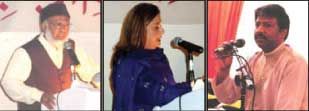Bazm Honors the Work
of Mir, Daagh, Momin & Jigar
By Ras H. Siddiqui

Left to right: Prof. Ahsan Syed, Annie Akhtar and
Sudhir Narain
|
Bazm-e-Arbab-e Sukhan (or
just Bazm), a group dedicated to the promotion of Urdu and
its formidable poetry here in Northern California, held
an evening of remembrance and scholarship on August 4th
in the San Francisco Bay area to the delight of many who
have developed a love for the language far away from its
roots.
The remembrance was of Professor Hassan Jahangir Hamdani
who recently passed away and whose absence at Bazm gatherings
is bound to be felt for quite some time. The scholarship
segment was dedicated to some of the oldest craftsmen of
Urdu which enhanced its early beginnings in the United Provinces
in what is now India. The focus here was on the work of
Mir Taqi Mir, Daagh, Momin and Jigar Moradabadi but the
omission of some others was just not possible. And finally
when someone as talented as Sudhir Narain, who is a part
of the Ghazal singing tradition (from Agra, home of the
Taj Mahal) is part of the program, it is nothing less than
icing on the cake.
The start was obviously on a somber note. An emotional Annie
Akhtar moved us with some of Bazm’s memories of Hamdani
Sahib. A pictorial slide show of Professor Hamdani’s
services to Urdu, Muslims, South Asians (of all religions)
was presented as Tashie Zaheer narrated. “Church,
Masjid, Mandir or Gurdwara” Hamdani Sahib made his
presence felt everywhere. Doctor Waheed Siddiqee and Professor
Ahsan Syed paid their own tributes to Professor Hamdani.
And none other than the very accomplished Noshi Gilani was
there to present her work: “Sabr, sabr, magar, Aakhir
kitna sabr?” she asked. “Mout say rag-e-jaan
ka kitna faasla hota hai?” she continued. Very true
and difficult words from Noshi included her last recollections
of Hamdani Sahib. Indeed “Roshni kabhi nahin marti.”
And last but not least the poetry of Farooq Taraz moved
us all. “Dard-e-hijr-e-yaar mein koi aazaan nahin.
Aaj Humdum, paas meray mera Hamdani nahin.”
The second segment was nothing short of educational. Urdu,
the lingua franca of millions in Pakistan and India (not
to forget the pockets now in the Gulf states and Bangladesh
and here in North America), needs to be passed on to future
generations. And the best way of doing this is to present
its old poetry via the new technology (computer aided) mediums.
That was exactly what occurred as a few lines from the works
of numerous old poets were presented along with their profiles
by Dr. Waheed Siddiqee and Professor Ahsan Syed, our resident
expert. Some who were impatient and will argue that this
went on for too long before the musical segment need to
understand that Bazm is not just about entertainment. It
is about the promotion of a language and a culture which
Annie Akhtar and Sahab Siddiqui along with a number of supporters
from Pakistan and India who are now Americans take quite
seriously.
And then the entertainment section arrived which delighted
the audience. Sudhir Narain is a wonderful ghazal singer
and a credit to this art. He hails from Agra in India and
it sometimes feels like he brings with him the beauty of
its most beautiful monument within his voice. He may not
be as well known as many of the others like Jagjit Singh
both in his homeland, in America and in Pakistan, but it
is time that he makes his presence felt there.
A performance each in Karachi and Lahore would be of immense
benefit to the connoisseurs of the Urdu ghazal resident
in these cities and would greatly enhance his career.
And with that we close here with two lines from one of Sudhir
Narain’s most famous singing attempts. The words are
from Ghalib. “Meri qismat mey gham gar itna tha, Dil
bhi ya Rab kayi deyay hotay.” And to that, what can
a writer in English possibly add?
-------------------------------------------------------------------------------------

